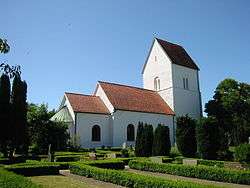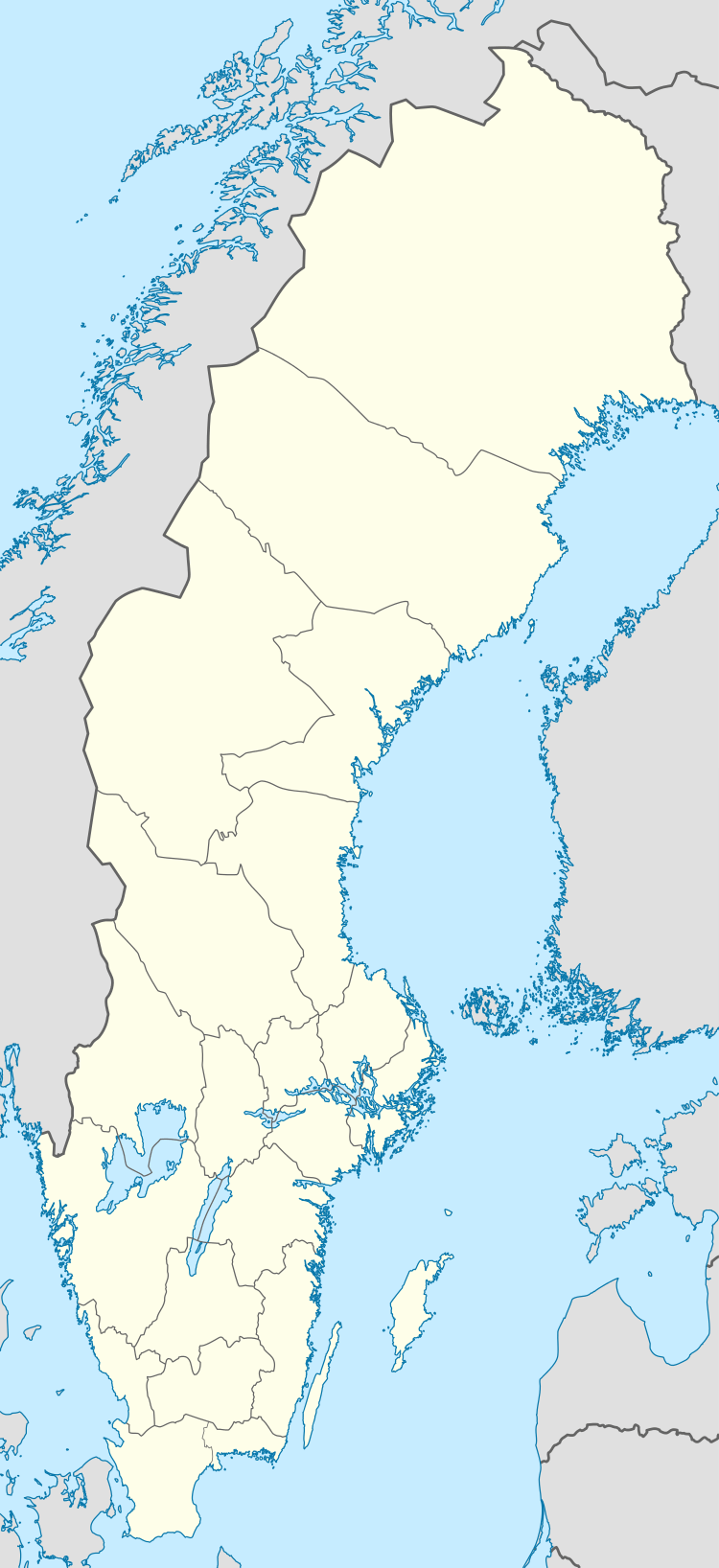Lilla Harrie
Lilla Harrie (Swedish pronunciation: [ˈlɪ̂lːaˌharːɪɛ])[2] is a locality situated in Kävlinge Municipality, Skåne County, Sweden with 371 inhabitants in 2010.[1]
Lilla Harrie | |
|---|---|
 Lilla Harrie Church | |
 Lilla Harrie  Lilla Harrie | |
| Coordinates: 55°48′N 13°12′E | |
| Country | Sweden |
| Province | Skåne |
| County | Skåne County |
| Municipality | Kävlinge Municipality |
| Area | |
| • Total | 0.41 km2 (0.16 sq mi) |
| Population (31 December 2010)[1] | |
| • Total | 371 |
| • Density | 909/km2 (2,350/sq mi) |
| Time zone | UTC+1 (CET) |
| • Summer (DST) | UTC+2 (CEST) |
Here is situated Lilla Harrie Valskvarn,[3] Sweden's oldest mill, founded in 1509 and bought by the archbishop. The purchase was approved and thereby registered. It is believed that the mill is much older.
In 1871, Måns Olsson became tenant of the mill after having undergone an apprenticeship. When industrialization came in the early 1900s the stone mill was replaced by a more modern roller mill. Lilla Harrie roller mill has always invested in good quality and it imported most machines from Bühler in Switzerland, which today is considered to be the best remaining production machines in the world.
Later, his son Edwin bought the mill. He replaced the water wheel with a water turbine which gave more power out of the stream. During World War II, he bought a new grindworks from Switzerland, which was seen as having the best maintained machines and systems still remaining.
1955: Edvin Helge took over the mill and modernized much of the old mill. Among some new addition were the concrete silos that helped in increasing production capacity further.
Lilla Harrie Engineering AB
The company founder's name was Nils Holmqvist, who was born in 1851. He started a small workshop in Östraby when he was 27 years old. Together with carpenter Per Paulsson, where he produced, among other things, horse-powered threshers long straw and later an ångtröska. In 1890 he bought an old smithy in Lilla Harrie. An assistant, Carl Tengvall, went in advance to Lilla Harrie and met the family Holmqvist with the words: "What should we do here, when we had it so good in Östraby."
Immediately they built a house next to the smithy. This house is still standing. Besides shoeing horses and repairing peasants equipment, they started to make wagons, plows, horse hoes, cultivators and more. Many artisans were employed by Nils Holmqvist. A couple of them was Per Paulsson and his son Charles who was hired before the 1910. Charles later started his own and still manage his son and grandsons and their sons Pålsson machines in the village of Lilla harrie.
When the railway came to the village in 1905 the work became impractical and 1-acre (4,000 m2) of land was purchased next to the track. The first industrial building was completed in 1906 with a power source for machinery in the form of an 8 hp (6.0 kW) kerosene engine. This building is the one who has "draksvansfönster" on the roof. The staff was in 1918 just over 100 people.
The son Carl Holmqvist took over operations in 1932 after his father's death. During the war the business expanded and new buildings were constructed for welding and painting. Carl Holmqvist left the CEO post in 1956 to his brother Gustav. Exhibition Hall, which is now owned by Neuero, was built in 1960. The huge factory hall (30 × 105 m) was built in 1966 and a year later came the third generation, Nils H. Holmqvist to the CEO. In the 1960s recession was built including motor and sailing yachts in search of new markets. The staff was 1976-135 people. Mainly because of-failing market and the launch of a multiline betupptagare, which according to hearsay, erosion of working capital, ceased operations in 1981, after almost 100 years.
The Battle of Lund
The Swedish army, under the leadership of King Charles XI, made camp in Lilla Harrie, one month before the skirmish. On the night of 4 December 1676, the Swedes made a successful flanking manoeuvre, by crossing the frozen Kävlingeån stream. Thereby surprised King Christian V and his Danish army, who later on lost the battle of Lund. The skirmish was one of the Scandinavians' bloodiest; 9000 soldiers lost their lives.
References
- "Tätorternas landareal, folkmängd och invånare per km2 2005 och 2010" (in Swedish). Statistics Sweden. 14 December 2011. Archived from the original on 10 January 2012. Retrieved 10 January 2012.
- Jöran Sahlgren; Gösta Bergman (1979). Svenska ortnamn med uttalsuppgifter (in Swedish). p. 10.
- Farina